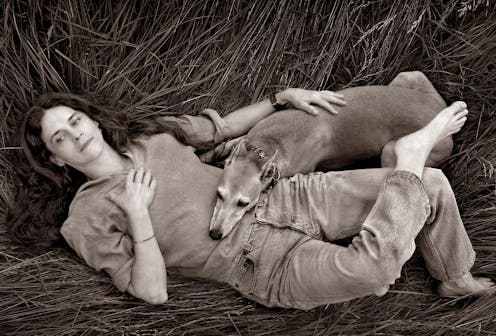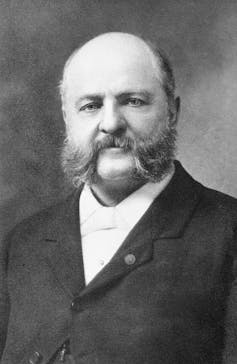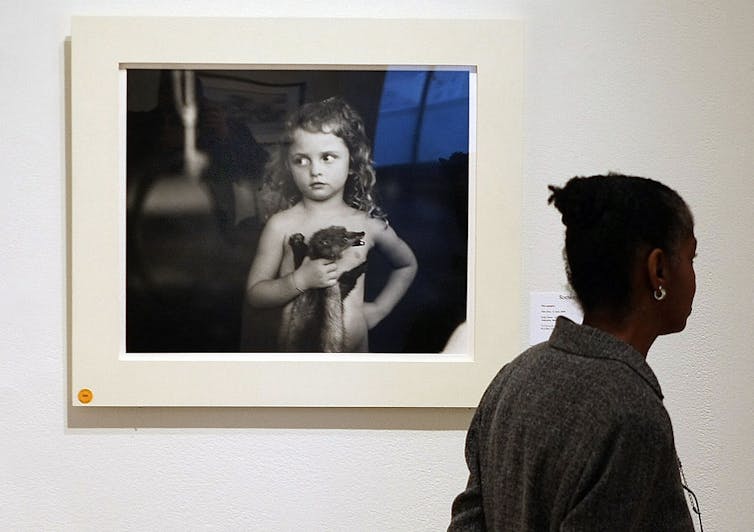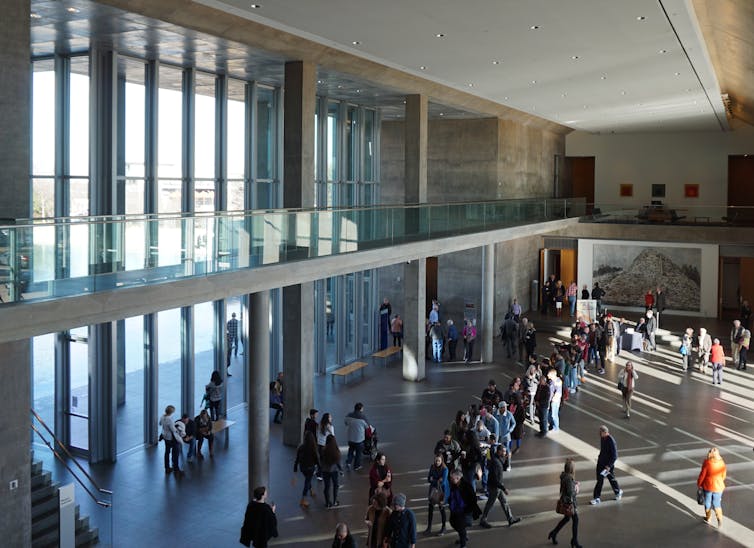Seizure of Sally Mann’s photographs in Texas revives old debates about obscenity and freedom of expr
A historian of artistic censorship sees chilling similarities to 19th-century anti-obscenity crusades.

Four photographs by celebrated artist Sally Mann were recently removed from the walls of an exhibition at the Modern Art Museum of Fort Worth at the behest of local Republican officials, who claimed they constituted child pornography. The Fort Worth Police Department is now investigating the allegation.
Those photographs – taken more than 30 years ago – feature Mann’s children posing in the nude on the family’s isolated farm in rural Virginia. They were included in an exhibition titled “Diaries of Home,” which also featured images by renowned photographers LaToya Ruby Frazier, Nan Goldin and Catherine Opie, among others.
One of the seized photographs depicts her son’s naked torso dripping with a melted popsicle, suggesting the innocence and messiness of childhood. In another, Mann’s naked daughter tiptoes across a tabletop, evoking both her strength and vulnerability.
For decades, these works have elicited admiration and, yes, condemnation.
I’m an art historian, and my most recent book documents the rise of art censorship following passage of the nation’s first federal anti-obscenity law in 1873, which became known as the Comstock Act after its chief lobbyist, the Christian evangelical activist Anthony Comstock.
Today, the Comstock Act is in the news mostly because it prohibits abortion medication, which was considered a form of obscenity alongside erotic images, sculptures and sex toys. But in the law’s early years, it was used to confiscate vast quantities of art and literature deemed lewd, obscene or erotic. Though this form of censorship has since been deemed unconstitutional by various U.S. Supreme Court decisions, debates over what constitutes obscenity, child pornography and artistic expression persist.
To me, the events surrounding the removal of Mann’s photographs echo those of a censorious past.
Evangelical underpinnings
Throughout Comstock’s career, evangelical Christians served as the most fervent supporters of his work; they were behind the creation of the New York Society for the Suppression of Vice, which funded his investigations.

Comstock’s censorship campaigns varied. Sometimes he went after nude drawings, paintings and sculptures. But even relatively tame photographs of actresses wearing tights attracted his ire.
In Fort Worth, objections originated from local Christian activists and organizations. Chief among them was the Danbury Institute, which penned an open letter to the Fort Worth museum, accusing Mann’s photographs of “normalizing pedophilia” and the exhibition more generally of “promoting "the breakdown of the God-ordained definition of family” through its depiction of LGBTQ parents. In its mission statement, the institute declares that “Scripture is authoritative, inerrant, infallible, and sufficient.”
Comstock similarly believed that “God’s Law” ought to be the guiding standard for American jurisprudence. To justify seizing and destroying an enormous array of images and objects during his 43-year career, Comstock often claimed to be battling Satan.
His efforts were broadly popular when it came to the sexually explicit images that tended to circulate in bars and saloons. But he eventually ran afoul of Americans’ more liberal and pluralistic attitudes when he targeted art and popular culture.
Courts expand freedom of expression
Over the course of the 20th century, the Comstock Act lost most of its teeth.
Judges and juries increasingly upheld civil liberties claims in cases concerning freedom of expression, vastly expanding the scope of the First Amendment.
In 1973, the Supreme Court established the current three-part “test” for obscenity. The final prong of that test dictates that a work is not obscene if it has “serious literary, artistic, political or scientific value.”
In my view, there’s no credible claim that Mann’s long-celebrated photographs do not have serious artistic value.
Following the removal of Mann’s photographs, arts advocates were quick to point out that the seized images are featured on prominent museum websites around the country. The National Coalition against Censorship and Artists at Risk organization issued strong statements in support of the exhibition of Mann’s photographs.

The Fort Worth sheriff’s office, which is holding the images, is reportedly evaluating whether they violate Texas’ child pornography statute. But because Mann’s photographs do not depict any sexual acts, the only phrase in this state law that could be deemed relevant is “lewd exhibition,” with “lewd” defined as an intent to stimulate sexual desire.
Here, context is key. As one critic of the removal of Mann’s works pointed out, “Most everyone reading this can easily make a distinction between going to a museum and opening Pornhub.”
By selectively removing a few of Mann’s photographs from the exhibition and suggesting they may be child pornography, Texas officials stripped them of their context as works of art. In doing so, they introduced the photographs to an audience that would never have seen them in an art museum but that now may search for them online with prurient intent.
Once again, I can’t help but see a connection to Comstock’s crusades. His efforts backfired, to a degree, in that the targets of his ire, from student drawings of nude models to birth control literature, ended up getting more publicity than they otherwise would have.
Curators also play a role
Despite legal protections, curators are still sensitive to how works of art may offend viewers and have developed a set of practices to accommodate these sensitivities.
Three years ago, I interviewed curators and directors in academic art museums and galleries across the country as a fellow at the University of California National Center for Free Speech and Civic Engagement.
My research focused on how museum professionals deal with the exhibition of potentially controversial artwork. They spoke to me about a variety of best practices. For example, prominently displayed content warnings allow viewers to choose to opt in or avoid the exhibition altogether. Thoughtful placement of the works and supplemental commentary add more context and provoke thought and discussion.

The curators of “Diaries of Home” clearly followed these best practices.
They stated the objective of their exhibition: to “examine conceptions of home in all their complexity,” and to feature the perspectives of women, LGBTQ and nonbinary artists and subjects. A content warning was visible to audiences before they entered the gallery: “This exhibition features mature themes that may be sensitive for some viewers.” Museum staff provided wall labels, tours and artist discussions.
These contributions situate the exhibited artworks within a broader conversation about families in America today, which are diverse in makeup, in definition and in lifestyle.
In other words, they show how these are serious, thoughtful works of art.
Although I can’t imagine any sort of successful criminal prosecution will take place, I do think damage has been done. This may have been a goal from the start.
Threatening legal action undoubtedly has a chilling effect. The Modern Art Museum in Fort Worth must grapple with a potential loss of donors. It takes time, money and effort to respond to official and public critics.
In Comstock’s era, civil liberties activists, artists and arts organizations rose to the challenge of defending their freedom of speech.
Those who value artistic expression today will have to follow in their footsteps.
Amy Werbel receives funding from the State University of New York and the UC National Center for Free Speech and Civic Engagement.
Read These Next
Who thinks Republicans will suffer in the 2026 midterms? Republican members of Congress
The president’s party almost always loses seats in the midterms. More than two dozen Republican House…
As DOJ begins to release Epstein files, his many victims deserve more attention than the powerful me
Powerful men connected to Jeffrey Epstein are named, dissected and speculated about. The survivors,…
Why are some Black conservatives drawn to Nick Fuentes?
Black Americans and white nationalists have joined forces in the past. And a number of cultural and…






